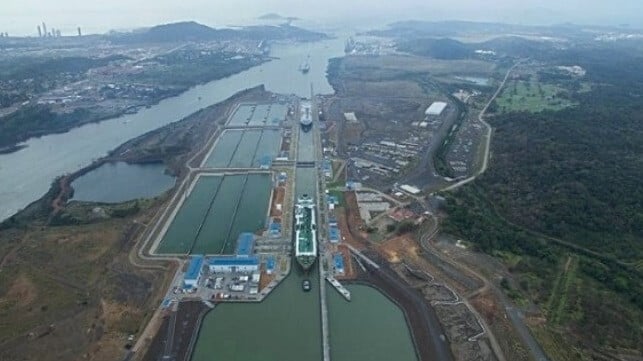Panama Canal Plans to Cut Transits by 40% Due to Ongoing Drought

The Panama Canal Authority released plans to drastically scale down transits at the canal phased in over the next three months as it reports water levels have continued to decline to unprecedented levels for this time of year. The current plan would see transits reduced by 43 percent by February 1, 2024, with large containerships, and LNG and LPG carriers, likely to be among the most impacted by the new round of cuts.
“The recorded precipitation for October has been the lowest on record since 1950,” writes the Panama Canal Authority in its new advisory. They are reporting that the rainy season was late in starting and with less than a month left is likely to fall far short of normal levels. October’s rainfall is 41 percent below normal levels resulting in 2023 ranking as the second driest year on record. Equally concerning for the canal’s operations are long-range weather forecasts showing that they can expect 38 percent less rain for the rest of the year.
After cutting the maximum draft of vessels from 50 feet to 44 feet, 39 feet at the Panamax Locks, the authority has been working to maintain the current levels. They decided to reduce the number of daily transits while also adopting water-saving and conservation measures. They highlight the addition of water-saving basins at the Neopanamax Locks and a technique of cross-filling at the Panamax Locks.
The canal, which has a capacity for 38 to 40 daily transits, has been operating at a total of 32 daily transits between the two locking systems since July 30 and was scheduled to go to 30 assigned slots on November 1. However, in an advisory released to customers dated October 30, the authority is outlining more drastic cuts.
The plan calls for a phased step down in capacity starting later this week at a total of 25 daily slots with the cuts coming entirely from what they call “supers,” the large vessels transiting the original locks of the canal. For the second half of November, they will cut one slot from the newer, larger Neopanamax Locks for a total of 24 daily slots, and then in December to 22 daily slots. The current plan calls for a total of 20 slots for January and 18 slots starting February 1.
The largest vessels that transit the Panama Canal, including containerships and LPG carriers will see transit cut by a third while the “supers,” which include LNG carriers, will see the number of daily trips reduced by more than 40 percent.
Analysts are highlighting that the cuts could impact the gas carrier segments especially hard. Rates for VLGC have already reached record highlights with reports saying it is mostly likely to impact propane and to a lesser extent butane shipments. The cuts will also come at a peak shipping season with much of the Northern Hemisphere in winter and normally driving strong demand for gas imports. It also comes as LNG use continues to rise in response to tightening environmental regulations on traditional fossil fuels and emissions.
During its last fiscal year, the Panama Canal recorded over 12,600 transits moving over 291 million tons of cargo. According to the canal’s daily traffic statistics posted online there are currently 94 vessels waiting for the transit, down slightly from the peak at over 100 vessels earlier in 2023 as they began to cut the number of available daily slots. After spiking, waiting times are currently down to an average of just under three days, but for large vessels including Neopanamax and Panamax Plus the waits are much longer. Neopanamax vessels without a reservation are waiting between four and five days on average while Panamax Plus vessels are between nine and 11 days. The cost of reservation slots soared to record highs in auctions after the cuts were announced at midyear.
The challenge for shippers and their carriers will increase due to the new limits with the expectation that more vessels may begin to divert to alternate routes even though they require greater distances. The larger containerships have already been forced to sail with smaller loads or offload containers for transshipment across Panama, an option not available to gas carriers and bulkers. Canal executives had previously predicted that the Panama Canal Authority would see a $200 million decline in revenues this physical year due to the restrictions.
